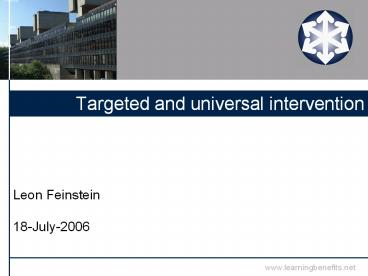Targeted and universal intervention - PowerPoint PPT Presentation
Title:
Targeted and universal intervention
Description:
How well can we identify those children at risk of adult ... People move in and out of risk. Progressive universalism is essential. Role of schools and GPs? ... – PowerPoint PPT presentation
Number of Views:44
Avg rating:3.0/5.0
Title: Targeted and universal intervention
1
Targeted and universal intervention
Leon Feinstein 18-July-2006
2
Five questions
- How well can we identify those children at risk
of adult social exclusion? - Which measures are most predictive?
- What difference does it make?
- What are the implications for the delivery of
services? - What are the implications for the targeting of
interventions?
3
E.g. Relationship of G1 maternal interest at G2
age 7 and G2-G3 parenting at G2 age 33
4
Relative cognitive shifts, 7 -11, by SES, 1958
Cohort
Source Feinstein, L. Schools and Educational
Attainment, Oxford Review of Economic Policy,
(in press)
5
(No Transcript)
6
Skills and capabilities Probability of being in
workless household with children at age 30
Source Feinstein, L. and Bynner, J. (Dec 2003),
The benefits of assets in childhood as
protection against adult social exclusion the
relative effects of financial, human, social and
psychological assets, Note to HM Treasury.
7
(No Transcript)
8
Conceptual model for family influences on child
development
9
Some cost-benefit notation
- C(T) The social cost of the outcome (Ttruth)
- P(T) The unconditional probability of the
outcome - P(D) The level of targeting of the intervention
- C(D) The cost of the intervention
- f the effectiveness of the intervention 0 f
1.
10
True and false positives
P(TP) P(D T) A / (AC) P(FP) P(D T-)
B / (BD)
11
Costs and benefits
- C(T-, D) The cost of a positive decision and
hence intervention for those who would not
experience the outcome (deadweight
stigmatisation costs) - C(T, D-) The cost of a negative decision and
hence failure to intervene for those who would
experience the outcome - B(T, D) The net benefit of a positive
decision and intervention for those who would
experience the outcome (net of intervention and
stigmatisation costs) - B(T-, D-) The net benefit of a negative
decision and absence of intervention for those
who would not experience the outcome.
12
- B(T, D)
- P(D, T) f C(T) P(D, T) C(D)
- P(TP) P(T) f C(T) C(D)
13
- C(T-, D) P(D-, T) C(D)
- P(FP) P(T-) C(D)
- Hence cost effectiveness requires
- P(TP) gt P(T-) C(D)
- P(FP) P(T) f C(T) C(D)
14
ROC Curves Allowing the allocation threshold to
vary
15
Optimal point on the ROC curve
- S P(T-) B(T-, D-) C(T-, D)
- P(T) B(T, D) C(T, D-)
16
2. Estimating P(TP) and P(FP)
17
Predicting teenage parenthood, by age
18
Predicting adult depression, by age
19
Predicting teenage parenthood, by domain
20
Predicting adult depression, by domain
21
Predicting other outcomes from age 10 measures,
1970 Cohort
22
Predicting other outcomes, P(TP), 1970
23
3. Preliminary discussion
- Targeting depends on identification
- Identification capabilities are very strong
- So targeted intervention is possible, but
- Ethical issues
- Stigmatisation
- Need effective and appropriate intervention
- Facilitated community engagement crucial
- People move in and out of risk
- Progressive universalism is essential
- Role of schools and GPs?































